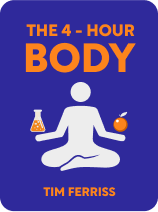

This article is an excerpt from the Shortform book guide to "The 4-Hour Body" by Timothy Ferriss. Shortform has the world's best summaries and analyses of books you should be reading.
Like this article? Sign up for a free trial here .
What is a body recomposition workout? How can it help transform your body?
The body recomposition workout is an exercise plan that helps burn fat and build muscle. Author Tim Ferriss used it to get results in The 4-Hour Body.
Read more about the body recomposition workout and the plans you can use.
Body Recomposition Workout Options
If you’re looking for a body recomposition workout, there are a few options. Below are two plans, each of which can be done on a machine or with free weights.
Workout #1
Machine Version
Do one set of the following:
- At least 7 pull-downs. Use a close, supinated (palms facing you) grip.
- At least 7 shoulder presses
- Optional: 10 myotatic crunches and 10 cat vomit exercises
Free Weight Version
Do one set of the following:
- At least 7 Yates rows. Bend at the waist at a 20-30 degree angle. Pick up a barbell with your palms facing away from you and let it hang with your arms straight. Lift it to your hip.
- At least 7 overhead presses with a barbell. Your feet should be shoulder-width apart or split, which protects your back. Don’t flare your elbows. When you lift the bar, pass it in front of your face, but at the top, it should be above your head.
- Optional: 10 myotatic crunches and 10 cat vomit exercises
Workout #2
Machine Version
Do one set of the following:
- At least 7 bench presses. (See Chapter 15 for bench press instructions.) Incline or decline the bench up to 20 degrees to protect your shoulders. If the bench isn’t adjustable, you can put a towel behind your lower back. Don’t lower the weights all the way—this will help reduce injury and increase your chest development.
- At least 10 leg presses. (The leg set has more reps because this will increase the hormone response of the whole body and form new capillaries.)
- Optional: 50 kettlebell swings
- 3 minutes on a stationary bike at a pace of at least 85 rpm. This will help reduce leg soreness. You don’t need to do any additional cardio because weight lifting activates the same system—the aerobic system—as cardio. This is because the point of the aerobic system is to serve muscles.
Free Weight Version
Do one set of the following:
- At least 7 bench presses. (See Chapter 15 for bench press instructions.) Use a shoulder-width grip.
- At least 10 weighted squats. Your feet should be slightly wider than shoulder-width and 12 inches in front of your hips. Sit back until your upper legs are parallel to the floor. Don’t pause or look down.
- Optional: 50 kettlebell swings
- 3 minutes on a stationary bike at a pace of at least 85 rpm. This will help reduce leg soreness.
General Rules for a Body Recomposition Workout
- There’s no need to do a warm-up before a body recomposition workout. Instead, start each set by doing three reps of each exercise at a 1/2 cadence (one second to lift, two seconds to lower) with 60% of the weight you’d use for a real set. This will reveal any joint problems or new injuries. The author has never seen anyone get injured using the protocol.
- You can train with a partner if you like, but make sure socializing doesn’t distract you. Don’t let your partner help or spot you, because then you may not be lifting the full weight yourself.
- Keep your shoulders in the locked position.
- Use a 5/5 cadence (five seconds to lift, five seconds to lower). Don’t pause during any of the movements except as noted in the exercise directions.
- Rest for exactly three minutes in between sets. (If you don’t want to get bulky, you can shorten the rest times to 30 seconds, which will target fat loss rather than muscle gain.)
- Never change anything except the weight and reps. Speed, rest, and form should all stay the same.
- Don’t do anything that isn’t part of the body recomposition workout. Doing extra could result in injury.
- By the end of each set, you should reach failure, the point at which it’s physically impossible for you to move the weight any more. Hold the weight at the failure point for five seconds and then slowly (take 5-10 seconds) lower it. The failure rep is the most important.
- For example, if you’re doing a push-up and can’t push yourself all the way back to the top, hold your body at the point where you’re stuck and then slowly lower yourself.
- Record the settings on the machine (for example, the seat adjustment) so that you can reproduce the same conditions every time.
Choosing Your Weights
To figure out which weight to start the program with:
- Choose a reasonable-seeming weight, do a set of five reps of each exercise (cadence fast but controlled on the up, and 2 seconds down), and rest 60 seconds.
- For example, say you start with 80 pounds on the pull-down.
- Increase the weight by 10% or 10 pounds, whichever is lighter, and do another five reps.
- For example, move up to a 90-pound weight.
- Keep increasing and resting until you fail to complete a set of five.
- For example, say at 110 pounds, you can only complete 4 reps.
- Once you fail, multiply the weight of the last set you successfully completed by 60% for the shoulder press and 70% for everything else. This is your starting weight (round to the closest available weight on the bar or machine).
- For example, say your last successful set was 100 pounds. Multiply this by 70% to get a starting weight of 70 pounds.
- Rest three minutes before beginning the protocol set.
- Rest five minutes before testing the weight for your next set.
After testing, only change the weight in between workouts, not during. Increase the weight whenever you can complete the minimum number of reps for all non-optional sets, and increase by 10% or 10 pounds, whichever is larger. If the new weight still feels easy after a few reps, pause for five minutes. Then add another 5-10 pounds.
Scheduling the Workouts
The general principle behind scheduling your workouts is that the stronger and bigger you get, the more time you need to rest. Muscles grow faster than they recover. Expert Dr. Doug McGuff found that most people get the most benefit from training less than once a week (putting aside benefits like sports being fun).
Before starting Occam’s Protocol, stop any training that damages your muscles (resistance training) for a week. Then, schedule your workouts as follows:
- Rest two days in between workouts #1 and #2.
- After you’ve done both workouts twice, rest three days in between them.
- When you hit a plateau in more than one exercise (you can’t increase the weight), rest four days in between workouts.
- Add another rest day in between workouts every time you hit a plateau.
- Once your workouts are spaced a week apart, if you’re not continuing to gain muscle, try splitting your workouts into two parts so that you’re training twice a week.
As far as workout time, studies have shown that people’s muscles are strongest between 4 pm and 6 pm. Pain tolerance for some conditions, such as arthritis, is highest between 4 pm and 5 pm. However, according to the author, most of these studies don’t take wake-up time into account. The author has found that for him, strength and pain tolerance are highest 8-10 hours after waking up (4 pm to 6 pm is 8-10 hours after a typical wake-up time of 8 am).
Regardless of when your ideal training time is, you should work out at around the same time every day so that you can accurately gauge your progress.

———End of Preview———
Like what you just read? Read the rest of the world's best book summary and analysis of Timothy Ferriss's "The 4-Hour Body" at Shortform .
Here's what you'll find in our full The 4-Hour Body summary :
- How to do the least amount you need to do for the results you want
- Why you need a cheat day in your diet
- How to improve everything about your body, including sleep, sex, and longevity






